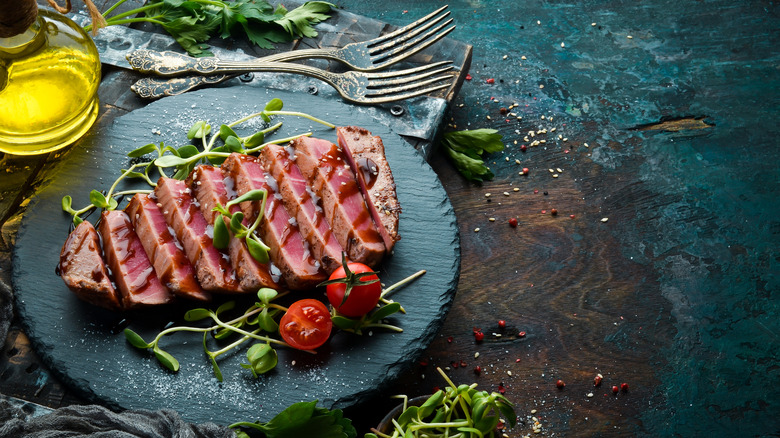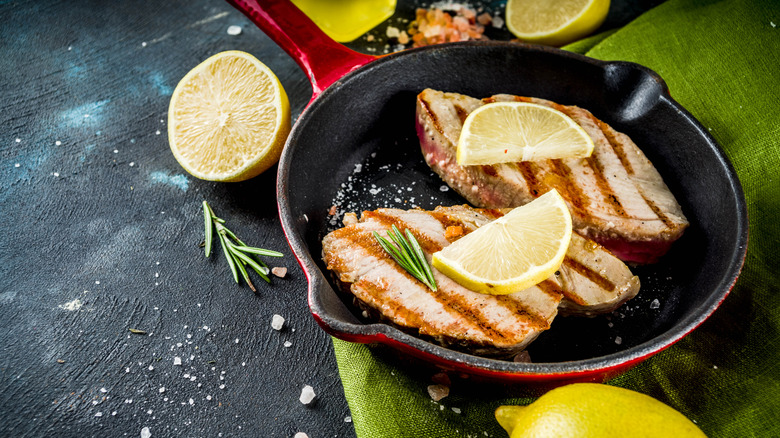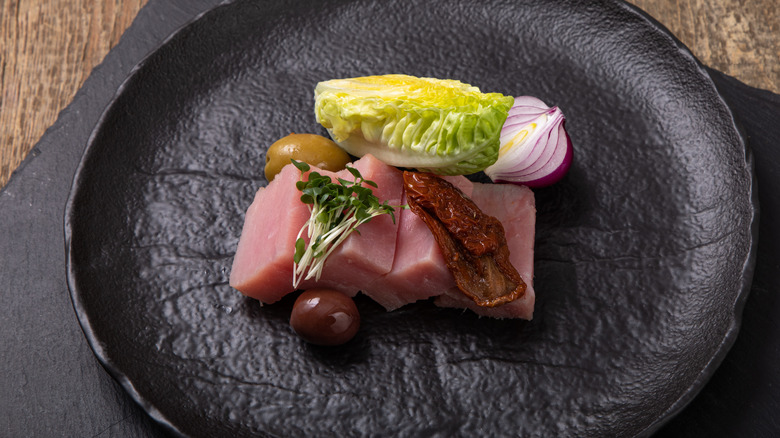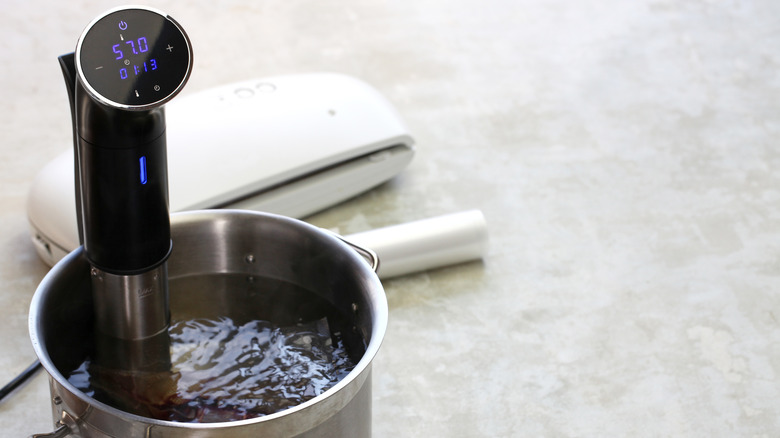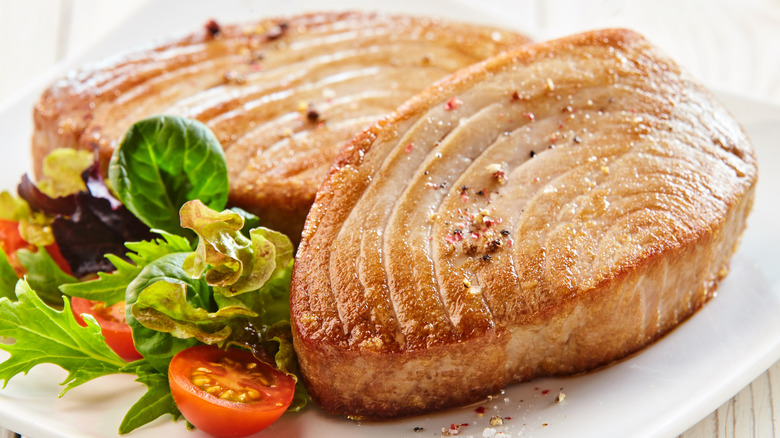The Best Ways To Cook Tuna Steak Without It Drying Out
Tuna is one of the culinary world's favorite fish. It can be found canned, grilled into steaks, or served up raw in sushi or a poke bowl. No matter how it's served, it's always a crowd-pleaser thanks to its mild but rich flavor. One problem that home chefs might encounter with tuna is its tendency to dry out. It's a fairly lean fish and overcooking can ruin the flavor and texture. Luckily, with a little care and attention, there are plenty of great ways to prepare a delicious tuna steak.
These methods are going to give you the best way to cook a tuna steak without it falling apart or getting dried out. Good preparation can help things as well. Some of the moisture loss can be prevented by using brine. According to Fish & Stream, using a wet brine can help fish like tuna by partially dissolving some of the muscle fibers into a gel that will hold its shape without drying out when cooked.
It's also important to buy sustainably caught tuna. According to the World Wildlife Foundation and the University of Chicago Press, Bigeye and Pacific Bluefin tuna have both been flagged as overfished and should be avoided when shopping for tuna steaks. There are still plenty of other types of tuna available out there that will have a smaller impact on their populations.
With a skillet or grill
One of the easiest methods to cook the perfect tuna steak without drying out is to flash fry it at high heat. This can be done on a grill, skillet, griddle, or any other high heat-safe cooking surface. BBC Good Food notes that tuna can dry out quickly and easily crumble, so a quick cooking time allows it to retain more moisture. The caramelized outer sear will also lock in much of the moisture per Better Homes and Gardens.
A tuna steak can be prepared in the traditional Japanese Tataki method (via Fine Dining Lovers). In this method, the outside of the steak is cooked completely, and the interior is left raw. Diners can enjoy the soft richness of raw tuna and crisp outer flesh with this preparation method.
Start by heating your preferred cooking surface on high and brush the steak's exterior with cooking oil and any seasonings (via BBC Good Food). Then gently place the tuna steak onto the cooking surface. Don't walk away, though. It only takes one to two minutes on each side, depending on the size of the steak, to sear. Steak University notes that tuna can also be cooked through completely by simply leaving the fish to cook longer. The best part is you won't even need to let it rest for a few minutes before serving.
The confit method
One of the more extravagant methods of preparing a tuna steak is to use a confit. The confit method is when a food is cooked in its own fats. A myriad of spices can also be added and infused into the fat and meat. It's most often done with duck but can be used for just about anything — including tuna.
According to Fine Cooking, tuna is too lean to render enough fat for this method, so olive oil takes its place instead. The delicate flavor of extra virgin olive oil makes for a great complement to the light flavors of a good tuna steak. Fine Cooking recommends using roughly three cups of decent olive oil for about two pounds of tuna steaks.
Put the oil and seasonings into a large pot or dutch oven and bring it to approximately 145 degrees Fahrenheit. Maintain this temperature for 20 minutes to infuse the oil with the flavor of the seasonings before letting it cool. Reheat the oil to medium-low and add the tuna steaks. Bring the temperature of the oil up to 150 degrees again before taking it off the heat and covering the pot. Allow it to cook for a couple of minutes before checking the meat for doneness. New York Times Cooking also has its own method, which uses less oil and boasts a different spice mix.
Using a sous vide machine
Sous vide is another excellent way to prepare tuna without the risk of losing too much moisture. Like the confit, this method prepares the steaks in a pool of liquid which helps maintain a moist cooking environment. This helps keep moisture in the steaks as well. Another great feature of the sous vide is that it gives the cook a lot of control over cooking time and temperature, and is easy to replicate (via Serious Eats).
For those who don't know, Sous vide is a method that involves sealing the meat inside of a bag and placing it in a pot of water that is heated and stirred by the sous vide machine. It maintains consistent heat throughout cooking and requires little oversight.
Anova Culinary notes that, like the other cooking methods, this one can be used to prepare steaks that are cooked completely or left raw in the center. They recommend seasoning the steaks lightly before sealing them in a bag and placing them in the water. The temperature can be set between 105 degrees and 130 degrees depending on the size of the steaks and desired level of doneness. Let the steaks cook for 30-45 minutes, then give them a quick sear in a pan for a nice crust. Serious Eats notes that it can also be served cold, similarly to sashimi, after being cooked at the lowest setting.
In the oven
The oven is another great method for cooking tuna steaks without sacrificing a juicy final product. Like the other methods, this one is dependent on a high heat per Better Homes and Gardens. This allows the tuna to safely cook without taking too much moisture out of the meat, leaving you with a crumbly, dry sheet pan full of steaks that look like they came out of the can.
Better Homes and Gardens recommends preheating the oven to 450 degrees Fahrenheit. Steaks should be dressed with olive oil, butter, or some kind of other fat, along with seasoning. They should then be placed onto a baking sheet in a single layer before baking for a quick six to seven minutes per every half-inch of thickness. Tuna is finished when it starts to flake, but it can continue to cook for longer if desired. Longer cooking times might sacrifice the moisture, giving you a dried-out tuna steak.
Once you decide how you want to cook you steak, you'll be ready to start planning which side dishes you want to prepare.
